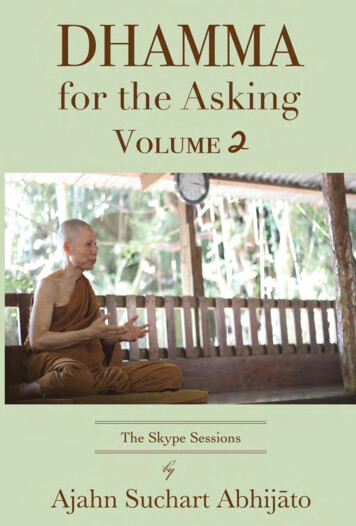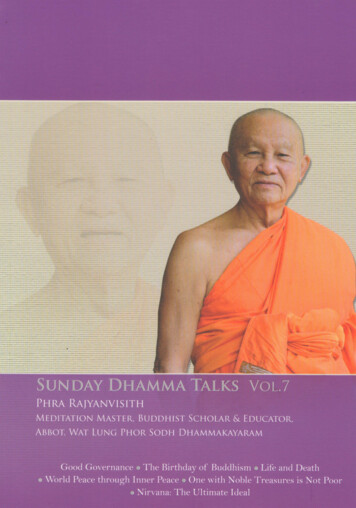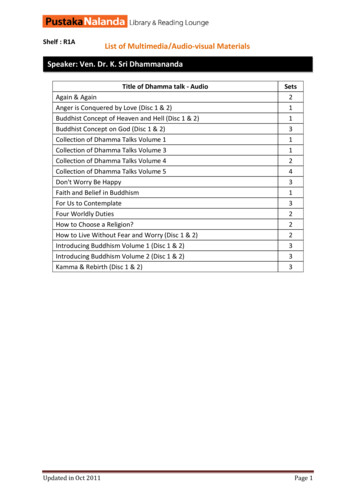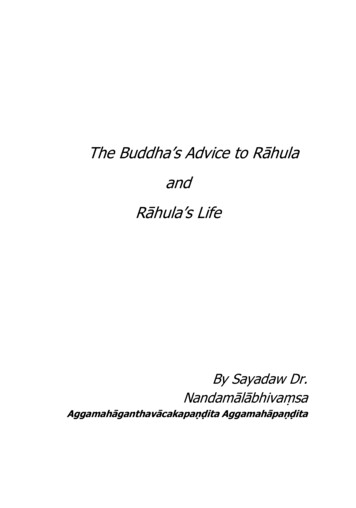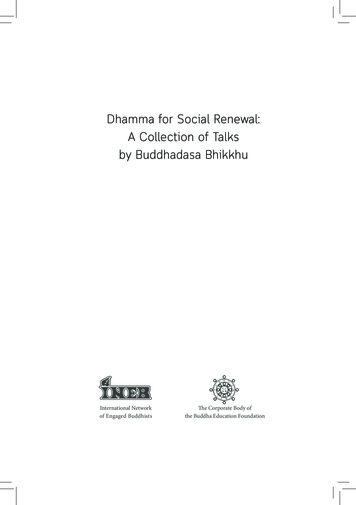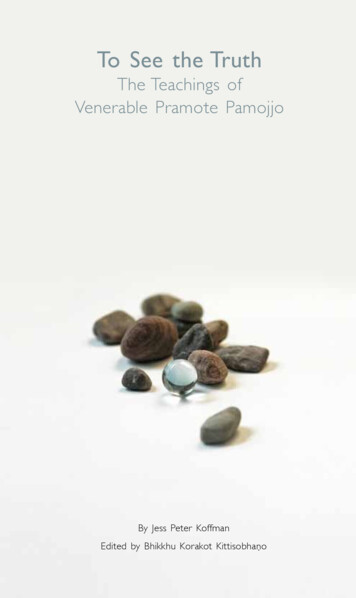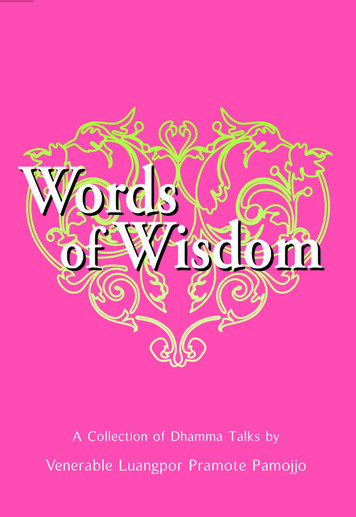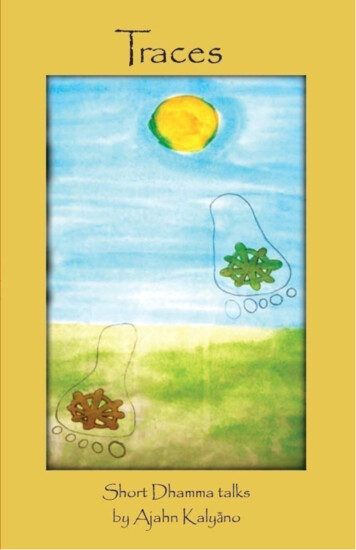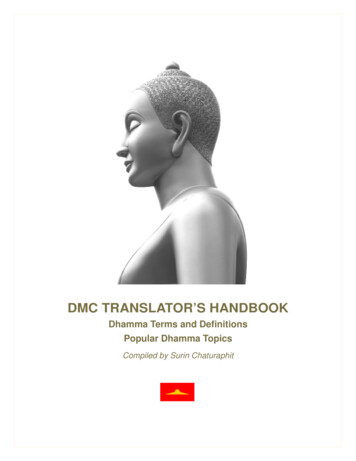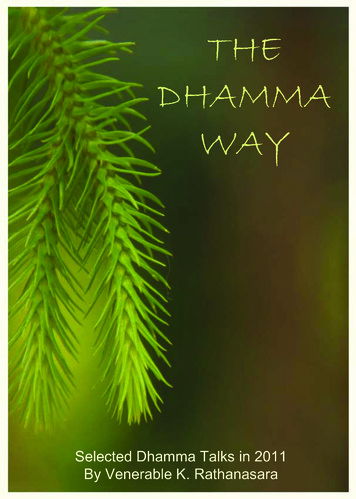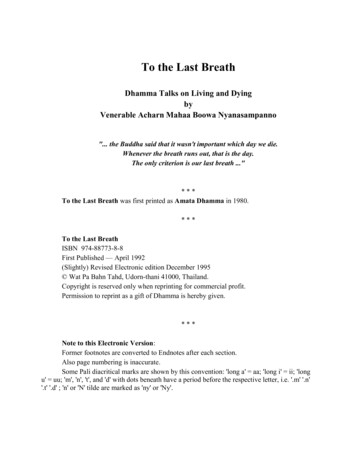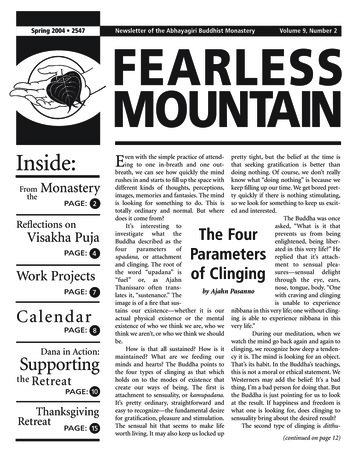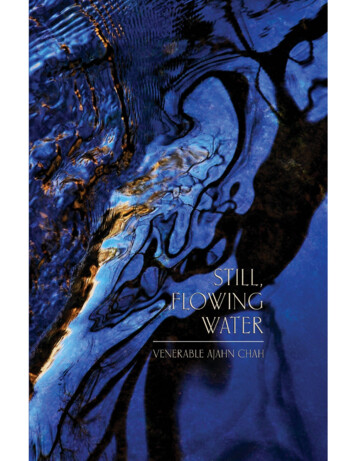
Transcription
Still,FlowingWaterEIGHTDHAMMATA L K SVenerableAjahn ChahT R A N S L AT E D F R O M T H E T H A I B YṬHĀNISSARO BHIKKHU
co p yri ghtCopyright 2013 Ṭhānissaro Bhikkhufo r ee di s tri buti o nYou may copy, reformat, reprint, republish, and redistribute this work inany medium whatsoever without the author’s permission, provided that: (1)such copies, etc. are made available free of any charge; (2) any translations ofthis work state that they are derived herefrom; (3) any derivations of thiswork state that they are derived and differ herefrom; and (4) you includethe full text of this license in any copies, translations or derivations of thiswork. Otherwise, all rights reserved.a dditi o na l res ourcesMore Dhamma talks, books and translations by Ṭhānissaro Bhikkhu areavailable to download in digital audio and various ebook formats atdhammatalks.org and accesstoinsight.org.p r i nte d co p yA paperback copy of this book is available free of charge. To request onewrite to: Book Request, Metta Forest Monastery, PO Box 1409, ValleyCenter, CA 92082 USA.questionsQuestions regarding this book may be addressed to: The Abbot, MettaForest Monastery, PO Box 1409, Valley Center, CA 92082 USA.
VENERABLE AJAHN CHAH
A Gift of DhammaA public talk given on October 10, 1977, addressed to the parents ofa monk who had come from France to visit their son.SO NOW There’s been not enough time . too little time . You’ve beenvisiting for many days now, and we haven’t had the chance to talk, to askquestions, because here at Wat Nong Pa Pong there’ve been many visitors, bothday and night. So we haven’t had the opportunity to talk. [Aside: Whoseparents are these?] [Answer: Ṭhitiñāṇo’s.] Ṭhitiñāṇo’s parents have come to visitfrom Paris for several days now, staying three nights at Wat Pa Pong and threenights at Wat Pa Nanachat. In two days you’re going to leave.So I’d like to take the opportunity to tell you how glad I am that you madethe effort to come here to Wat Nong Pa Pong and that you’ve had the chanceto visit with your son, the monk. I’m glad for you, but I don’t have any gift togive to you. There are already lots of material things and whatnot in Paris. Lotsof material things. But there’s not much Dhamma to nourish people’s heartsand bring them peace. There’s not much at all. From what I observed when Iwas there, all I could see were things to stir up the heart and give it trouble allthe time. From what I observed, Paris seems to be very advanced in terms of allkinds of material things that are sensual objects—sights, sounds, smells, tastes,tactile sensations, and ideas that act as temptations for people who aren’tfamiliar with the Dhamma, getting them all stirred up. So now I’d like to give agift of Dhamma that you can put into practice in Paris after you leave WatNong Pa Pong and Wat Pa Nanachat.The Dhamma is . [Are you going to translate as we go along?] [Yes.][Okay, but it’s not really convenient.]The Dhamma is a condition that can cut through and reduce the problemsand difficulties in the human heart—reducing them, reducing them untilthey’re gone. This condition is called Dhamma. So you should train yourself inthis Dhamma in your daily life. When any preoccupation strikes and disturbsthe mind, you can then solve the problem, you can resolve it. That’s becauseproblems of this sort, everyone—whether here in Thailand, abroad,
everywhere: If you don’t know how to solve this problem, it’s normal that yousuffer.When this sort of problem arises, the way to solve it is discernment:building discernment, training discernment, making discernment arise fromwithin our heart.As for the path of practice, it’s nothing far away. It’s right within you: inyour body and mind. It’s the same whether you’re Thai or from abroad. Thebody and mind are what stir up trouble. But the body and mind can bringpeace.Actually, the mind is already at normalcy. It’s like rain water, water that’snormally clear, pure, and clean. But if you put green or yellow dye into it, itturns green or yellow.It’s the same with the mind. If you meet up with a preoccupation you like,the heart feels good and at ease. If it meets up with a preoccupation you don’tlike, it feels dis-ease. It gets murky—like water that turns yellow when mixedwith yellow dye, black when mixed with black dye, green when mixed withgreen dye. It keeps changing its color. But actually, the water that’s yellow orgreen: Its normalcy is that it’s clear and clean. The normalcy of the mind is likerain water. It’s a mind that’s clear and clean. It’s a mind whose normalcy isn’tstirred up and troubled. The reason it’s stirred up and troubled is because ittakes after its preoccupations. It falls for its preoccupations.To put it so that you’ll see this clearly: Right now we’re sitting in a forestthat’s quiet, like a leaf. A leaf, if there’s no breeze blowing, is still. Quiet. If abreeze blows, it flutters in line with the breeze. The same with the mind. If itmakes contact with a preoccupation, it flutters in line with the preoccupation.The more it’s ignorant of the Dhamma, the more you keep letting it run loosein line with its moods. If the mood is happy, you let it run loose. If the mood isunhappy, you let it run loose, and it keeps staying stirred up—to the pointwhere people have nervous breakdowns, because they don’t know what’s goingon. They let things run loose in line with their moods. They don’t know howto care for their minds.When the mind has no one to care for it, it’s like a person with no parentsto care for it, a destitute person. A destitute person has no refuge. A personwho lacks a refuge suffers. The same with the mind. If it lacks training inmaking its views right, it’s put to all sorts of difficulties.
So the practice of bringing the mind to peace is called, in Buddhism, doingkammaṭṭhāna. Kammaṭṭhāna. Ṭhāna means foundation. Kamma is the work wehave to do. One part of this is the body; one part is the mind. That’s all thereis: these two things. The body is a rūpa-dhamma, a physical condition. It has ashape you can see with your eyes. The mind is a nāma-dhamma, a mentalphenomenon that doesn’t have a shape. You can’t see it with your eyes, but it’sthere. In ordinary language we call these things body and mind. The body youcan see with your physical eyes. The mind you can see with your inner eye, theeye of the mind. There are just these two things, but they’re all stirred up.So the practice of training the mind, the gift I’m giving you today, is simplydoing this kammaṭṭhāna. I’m giving it to you to train the mind. Use this mindto contemplate this body. Use this mind to contemplate this body.What is the mind? The mind isn’t “is” anything. But through oursuppositions we say it’s an awareness. It’s always aware of receivingpreoccupations. What’s aware of receiving preoccupations, we’ll call “mind.”Whatever is aware, that’s called the mind. It’s aware of preoccupations andmoods—sometimes happy, sometimes painful, moods of gladness, moods ofsadness. Whatever takes on the burden of being aware of these things is calledthe mind.The mind is right here right now. While I’m talking to you, the mind isaware of what I’m saying. When the sounds come into the ear, the mind isaware of what I’m saying. Whatever’s there, it’s aware of it. What’s aware:That’s called the mind. The mind has no body, no shape. It’s simply what’saware and nothing else. That’s called the mind.This mind, if we teach it to have right views, won’t have any problems. It’llbe at its ease. The mind will be the mind, the preoccupations will bepreoccupations. Preoccupations won’t be the mind; the mind won’t be itspreoccupations. We contemplate the mind and its preoccupations so that we’llsee clearly in our awareness that the mind receives and is aware ofpreoccupations that come passing in. These two things meet and give rise to anawareness in the mind—good, bad, hot, cold, all kinds of things. If we don’thave the discernment to straighten things out, the problems that come aboutin this way will put the mind in a turmoil.To do kammaṭṭhāna is to give the mind a foundation. The in-and-outbreath is our foundation. Take this—the breath coming in, the breath going
out—as the object of your meditation. Familiarize yourself with it. There arelots of other meditation objects, but they can cause difficulties. It’s better tostay with the breath. The breath has been the crown of all meditation objectsfrom time immemorial.You sit and meditate—when you have the chance, you sit and meditate.Put your right hand on top of your left hand, your right leg on top of your leftleg. Sit up straight. Think to yourself: “Right now I’m going to put aside all myburdens. I won’t concern myself with anything else.” Let go. Whateverresponsibilities you have, all your many responsibilities, let them go for thetime being. Teach your mind: “Right now I’m going to keep track of thebreath. I’ll be alert to one thing only: the breath.” Then breathe in, breatheout. When you focus on the breath, don’t make it long, don’t make it short,don’t make it light, don’t make it heavy. Let it be just right. Just right.Mindfulness is the ability to keep this in mind. Alertness is the awarenessthat comes from the mind. Let it know that the breath is going out. Let itknow that the breath is coming in. At ease. You don’t have to think about thisor that or anything at all. Just be aware in the present that “Right now my onlyduty is to focus on the breath. I don’t have any duty to think about anythingelse.” Then focus just on the breath going out, the breath coming in. Focusyour mindfulness to keep track of this. Make your alertness be aware that rightnow you have a breath.At first, when the breath comes in, the beginning of the breath is at the tipof the nose, the middle of the breath is at the heart, the end of the breath is atthe navel. When you breathe out, the beginning of the breath is at the navel,the middle of the breath is at the heart, the end of the breath is at the tip ofthe nose. Feel it in this way. The beginning of the breath, one—nose; two—heart; three—navel. Then one—navel; two—heart; three—nose. Focus onthese three stages and let all your concerns fade away. You don’t have to thinkof anything else. Focus on the breath. Focus on in. Always know the beginningof the breath, the middle of the breath, the end of the breath. The beginningof the breath, the middle of the breath, the end of the breath.Perhaps the mind may think of something. It’ll bring up the breath as itspreoccupation. It’ll evaluate the breath, contemplate it, staying involved withits preoccupation, keeping this up continually—knowing the beginning of thebreath, knowing the middle of the breath, knowing the end of the breath.
When you keep doing this, then citta-mudutā: The heart will be malleable.Kāya-mudutā: The body will be malleable. Its tiredness and stiffness willgradually disappear. The body will become light; the mind will gather together.The breath will grow more gentle and refined.Mindfulness and alertness will coalesce with the mind. Keep doing thisuntil the mind quiets down, grows still, and becomes one. One. The mind restswith the breath. It won’t separate out anywhere else. At ease. No disturbance.It knows the beginning of the breath, the middle of the breath, the end of thebreath. When you know this, stay focused on it at all times. When the mind isquiet, you can focus just on the end point and beginning point of the breath.You don’t have to follow it down into the body. In other words, stay just at thetip of the nose. The breath goes out, the breath comes in, goes out, comes in,but you don’t have to follow it down.When you do this, it’s called making the mind comfortable, at peace. Whenthe mind is at peace, let it stop and stay right there. It stops and stays with onepreoccupation. The mind is one. It stays with a single preoccupation, the inand-out breath, at all times. This is called making the mind quiet and makingit give rise to discernment.This is the beginning, the foundation of doing kammaṭṭhāna. Try to dothis every day, every day, wherever you are: at home, in your car, in your boat,sitting, lying down. Have mindfulness and alertness in charge at all times.This is called meditation (bhāvanā). There are many types of meditationand they can be done in all four postures, not only while you’re sitting. You cando them while standing, sitting, walking, or lying down. All that’s asked is thatyour mindfulness be always focused on knowing: “At this moment, what arethe characteristics of the mind? What mood is it in? Happy? Pained? Stirredup? At peace?” Observe it in this way. In other words, know what’s right andwrong in your mind at all times. This is called making the mind quiet.When the mind is quiet, discernment will arise; discernment will know;discernment will see. When the mind is quiet, use the quiet mind tocontemplate. Contemplate what? It’s kammaṭṭhāna: your body from the headdown to the toes, from the toes up to the head. Use the quiet mind to keepcontemplating back and forth. Look at hair of the head, hair of the body, nails,teeth, and skin as your kammaṭṭhāna. See that all bodies have earth, water, fire,and wind. These four groups are called kammaṭṭhāna. They’re called properties:
the earth property, the water property, the fire property, the wind property.When they come together, we call them a “human being,” a “living being.” Butthe Buddha said to see them just as properties. The parts of the body that aresolid are earth, the earth property. The liquid parts that circulate in the bodyare called the water property. The breath that flows up and down is called thewind property. The heat and warmth in the body is called the fire property.A person, when analyzed, has only these four things: earth, water, fire,wind. There’s no “being,” no “human being.” There’s nothing: no Thai, noWesterner, no Cambodian, no Vietnamese, no Lao. Nobody. There’s just earth,water, fire, and wind. But we suppose these things into being a person, a livingbeing. But actually you’ll come to see that there’s nothing at all to this earth,water, fire, and wind that we call a human being. They’re composed ofinconstancy, stress, and not-self. They’re not for sure. They keep cycling aroundand changing. They don’t say in place. Even our body isn’t for sure. It keepsmoving around, changing. The hair of the head changes, the hair of the bodychanges, the skin changes. Everything keeps changing.Even the heart is the same way. It’s not our self, it’s not “us,” it’s not “him”or “her.” It can think all kinds of things. Sometimes it can think of committingsuicide, sometimes it can think pleasant thoughts, sometimes it can thinkpainful thoughts—all kinds of things. It’s not for sure. If you don’t have anydiscernment, you believe it—this one mind that can keep lying to you: sad,happy, all mixed up together. This is what we mean when we say that the mindisn’t for sure. The body isn’t for sure. In short, they’re both inconstant, bothstressful, both not-self. The Buddha said that these things aren’t a being, aren’ta person, aren’t our self, aren’t us or anyone else. They’re properties, that’s all:earth, water, fire, and wind.This is contemplation. Use the mind to contemplate until it sees clearly allthe way down.When it sees clearly all the way down, the clinging that teaches us thatwe’re beautiful, good, bad, unhappy, right, whatever, gets uprooted. Removed.You see everything as one and the same thing: human beings, animals.Westerners are one and same with Thais; Thais, one and the same withWesterners. Everything. It’s all properties: earth, water, fire, wind. When themind sees in this way, it uproots every clinging out of itself. When youcontemplate and see inconstancy, stress, and not-self— that there’s no “us,” no
“being”—you give rise to a sense of chastened dismay. You uproot yourclingings, uproot your clingings. You don’t have to cling to anything at all as“you” or your self or anyone else.When the mind sees in this way, it gives rise to disenchantment.Dispassion. In other words, when it sees everything as inconstant, stressful, andnot-self, it stops. It becomes Dhamma. Passion, aversion, and delusion keepwasting away, wasting away until nothing is left but Dhamma: this mind.That’s all there is.This is what’s meant by doing kammaṭṭhāna.So I give this to you to take and contemplate. Study it every day in youreveryday life. Even though you’ve received these teachings from Wat Nong PaPong or Wat Pa Nanachat, they’re an heirloom that’s been passed down. Iadvise you—as do all the monks, the ajaans, and your son the monk—to takethis gift of Dhamma and contemplate it. Your heart will be at ease. It won’t betroubled any more. It’ll be at peace. If the body is disturbed, don’t worry aboutit. Make sure the mind isn’t disturbed. If people in the world are disturbed,we’re not disturbed along with them. Even though there may be a lot ofdisturbance in your foreign land, you don’t have to be disturbed—because yourmind has seen. It’s Dhamma.This is a good path, a correct path. So remember it and contemplate it.
Our Real HomeThis is a talk that Ajahn Chah recorded at the request of one of hisstudents whose mother was on her deathbed. The student hadexpected just a short message for his mother, but instead Ajahn Chahgave this extended talk of consolation and encouragement for themother and the whole family.Namo tassa bhagavato arahato sammā-sambuddhassa.Homage to the Blessed One, the Worthy One, the Rightly Self-awakened One.Sīlena sugatiṁ yanti: Through virtue they go to a good destination.Sīlena bhogasampadā: Through virtue there’s consummation of wealth.Sīlena nibbutiṁ yanti: Through virtue they go to nibbāna.Tasmā sīlaṁ visodhaye: So virtue should be purified.NOW, GRANDMA, set your heart on listening respectfully to the Dhamma,which is the teaching of the Buddha. While I’m teaching you the Dhamma, beas attentive as if the Buddha himself were sitting right in front of you. Closeyour eyes and set your heart on making your mind one. Bring the Buddha,Dhamma, and Saṅgha into your heart as a way of showing the Buddha respect.Today I haven’t brought you a gift of any substance, aside from theDhamma of the Buddha. This is my last gift to you, so please accept it.You should understand that even the Buddha—with all his virtues andperfections—couldn’t avoid the weakening that comes with aging. When hereached the age you are, he let go. He let go of the fabrications of life.“Letting go” means that he put these things down. Don’t carry themaround. Don’t weigh yourself down. Accept the truth about the fabrications ofthe body, whatever they may be: You’ve relied on them since you were born,but now it’s enough. Now that they’re old, they’re like the utensils in yourhome—the cups, the saucers, and the plates—that you’ve held onto all theseyears. When you first got them they were bright and clean, but now they’re
wearing out. Some of them are broken, some of them are lost, while the onesremaining have all changed. They haven’t stayed the same. That’s just the waythings are.The same holds true with the parts of your body. From the time of birthand on through your childhood and youth, they kept changing. Now they’recalled “old.” So accept the fact. The Buddha taught that fabrications aren’t us,they aren’t ours, whether they’re inside the body or out. They keep changing inthis way. Contemplate this until it’s clear.This body of yours, lying here and decaying, is the truth of the Dhamma.This truth is a teaching of the Buddha that’s certain and sure. He taught us tolook at it, to contemplate it, to accept what’s happening. And it’s somethingyou should accept, regardless of what’s happening.The Buddha taught, when we’re imprisoned, to make sure that it’s only thebody that’s imprisoned. Don’t let the mind be imprisoned. And the same thingapplies here. When the body wears out with age, accept it. But make sure thatit’s only the body that’s wearing out. Make sure that the affairs of the mind aresomething else entirely. This gives your mind energy and strength, because yousee into the Dhamma that this is the way things are. This is the way they haveto be.As the Buddha taught, this is the way the body and mind are of their ownaccord. They can’t be any other way. As soon as the body is born, it begins toage. As it ages, it gets sick. After it’s sick, it dies. This truth is so true, thistruth you’re encountering today. It’s the truth of the Dhamma. Look at it withyour discernment so that you see.Even if fire were to burn your house, or water were to flood it, or whateverthe danger that would come to it, make sure that it’s only the house that getsburned. Make sure your heart doesn’t get burned along with it. If water floodsyour house, don’t let it flood your heart. Make sure it floods only the house,which is something outside the body. As for the mind, get it to let go and leavethings be—because now is the proper time, the proper time to let go.You’ve been alive for a long time now, haven’t you? Your eyes have had thechance to see all kinds of shapes, colors, and lights. The same with your othersenses. Your ears have heard lots of sounds, all kinds of sounds—but they wereno big deal. You’ve tasted really delicious foods—but they were no big deal.The beautiful things you’ve seen: They were no big deal. The ugly things you’ve
seen: They were no big deal. The alluring things you’ve heard were no big deal.The ugly and offensive things you’ve heard were no big deal.The Buddha thus taught that whether you’re rich or poor, a child or anadult—even if you’re an animal or anyone born in this world: There’s nothingin this world that’s lasting. Everything has to change in line with its condition.The truth of these conditions—if you try to fix them in a way that’s not right— won’t respond at all. But there is a way to fix things. The Buddha taught usto contemplate this body and mind to see that they aren’t us, they aren’t ours,they’re just suppositions.For example, this house of yours: It’s only a supposition that it’s yours.You can’t take it with you. All the belongings that you suppose to be yours arejust an affair of supposition. They stay right where they are. You can’t takethem with you. The children and grandchildren that you suppose to be yoursare just an affair of supposition. They stay right where they are.And this isn’t just true for you. This is the way things are all over theworld. Even the Buddha was this way. Even his enlightened disciples were thisway. But they differed from us. In what way did they differ? They accepted this.They accepted the fact that the fabrications of the body are this way by theirvery nature. They can’t be any other way.This is why the Buddha taught us to contemplate this body from the solesof the feet on up to the top of the head, and from the top of the head on downto the soles of the feet. These are the parts of your body. So look to see whatall is there. Is there anything clean? Anything of any substance? These thingskeep wearing down with time. The Buddha taught us to see that thesefabrications aren’t us. They’re just the way they are. They aren’t ours. They’rejust the way they are. What other way would you have them be? The way theyare is already right. If you’re suffering from this, then your thinking is wrong.When things are right but you see them wrong, it throws an obstacle acrossyour heart.It’s like the water in a river that flows downhill to the lowlands. It flows inline with its nature. The Ayutthaya River, the Muun River, whatever the river,they all flow downhill. They don’t flow uphill. That’s their nature.Suppose a man were to stand on the bank of a river, watching the currentflowing downhill, but his thinking is wrong. He wants the river to flow uphill.He’s going to suffer. He won’t have any peace of mind. Whether he’s sitting,
standing, walking, or lying down, he won’t find any peace. Why? Because histhinking is wrong. His thinking goes against the flow. He wants the water toflow uphill, but the truth of the matter is that the water can’t flow uphill. It’snot appropriate. The nature of the water is that it has to flow along with theflow. That’s its nature.When this is the case, the man is upset. Why is he upset? Because histhinking is wrong, his ideas are wrong, all because of his wrong view. Rightview sees that water has to flow downhill. This is a truth of the Dhamma thatwe can contemplate and see that it’s true. When that man sees this truth, hecan let go—he can let the water flow along with its flow. The problem that waseating away at his heart disappears. When the problem disappears, there’s nomore problem. When there’s no problem, there’s no suffering.It’s the same here. The water flowing downhill is like the life of your body.After it’s young, it’s old. When it’s old, it flows along in its way. Don’t thinkthat you don’t want it to be that way. Don’t think like that. We don’t have thepower to fix it.The Buddha looked at things in line with their conditions, that they simplyhave to be that way. So we let them go, we leave them be. Take your awarenessas your refuge. Meditate on the word buddho, buddho. Even though you’re reallytired, put your mind with the breath. Take a good long out-breath. Take agood long in-breath. Take another good long out-breath. Focus your mindagain if you wander off. Focus on the breath: buddho, buddho.The more tired you feel, the more refined you have to keep focusing on inevery time. Why? So that you can contend with pain. When you feel tired, stopall your thoughts. Don’t think of anything at all. Focus the mind in at themind, and then keep the mind with the breath: buddho, buddho. Let go ofeverything outside. Don’t get fastened on your children. Don’t get fastened onyour grandchildren. Don’t get fastened on anything at all. Let go. Let the mindbe one. Gather the mind in to one. Watch the breath. Focus on the breath.Gather the mind at the breath. Just be aware at the breath. You don’t have tobe aware of anything else. Keep making your awareness more and more refineduntil it feels very small, but extremely awake.The pains that have arisen will gradually grow calm. Ultimately, we watchthe breath in the same way that, when relatives have come to visit us, we seethem off to the boat dock or the bus station. Once the motor starts, the boat
goes whizzing right off. We watch them until they’re gone, and then we returnto our home.We watch the breath in the same way. We get acquainted with coarsebreathing. We get acquainted with refined breathing. As the breathing getsmore and more refined, we watch it off. It gets smaller and smaller, but wemake our mind more and more awake. We keep watching the breath get moreand more refined until there’s no more breath. There’s just awareness, wideawake.This is called meeting with the Buddha. We stay aware, awake. This is whatbuddho means: what’s aware, awake, serene. When that’s the case, we’re livingwith the Buddha. We’ve met with awareness. We’ve met with brightness. Wedon’t send the mind anywhere else. It gathers in here. We’ve reached ourBuddha. Even though he’s already passed away, that was just the body. The realBuddha is awareness that’s serene and bright. When you meet with this, that’sall you have to know. Let everything gather right here.Let go of everything, leaving just this singular awareness. But don’t getdeluded, okay? Don’t lose track. If a vision or a voice arises in the mind, let itgo. Leave it be. You don’t need to take hold of anything at all. Just take hold ofthe awareness. Don’t worry about the future; don’t worry about the past. Stayright here. Ultimately you get so that you can’t say that you’re going forward,you can’t say that you’re going back, you can’t say that you’re staying in place.There’s nothing to be attached to. Why? Because there’s no self there, no you,no yours. It’s all gone.This is the Buddha’s teaching: He tells us to be “all gone” in this way. Hedoesn’t have us grab hold of anything. He has us be aware like this—aware andletting go.This is your duty right now, yours alone. Try to enter into the Dhamma inthis way. This is the path for gaining release from the round of wandering-on.Try to let go, to understand, to set your heart on investigating this.Don’t be worried about this person or that. Your children, yourgrandchildren, your relatives, everybody: Don’t be worried about them. Rightnow they’re fine. In the future they’ll be just like this: like you are right now.Nobody stays on in this world. That’s the way it has to be. This is a condition,a truth, that the Buddha taught. All the things that don’t have any truth tothem, he has us leave them be. When you leave them be, you can see the truth.
If you don’t leave them be, you won’t see the truth. That’s the way things are.Everybody in the world has to be this way. So don’t be worried. Don’t fastenonto things.If the mind is going to think, let it think, but think using discernment.Think with discernment. Don’t think with foolishness. If you think about yourgrandchildren, think about them with discernment, not with foolishness.Whatever there is, you can think about it, you can be aware of it, but thinkwith discernment, be aware with discernment. If you’re really aware withdiscernment, you have to let go. You have to leave things be. If you think withdiscernment and are aware with discernment, there’s no suffering, no stress.There’s just happiness, peace, and respite, all in one. The mind gathers like this.All you need to hold onto in the present is the breath.This is your duty now. It’s not the duty of anyone else. Leave their dutiesto them. Your duty is your duty. And your duty right now is to keep yourawareness at your mind, making sure it doesn’t get stirred up. Your duty is toknow how your mind is doing. Is it worried about anything? Is it concernedabout anything? Examine the mind while you’re lying here sick. Do
dhammatalks.org and accesstoinsight.org. printed copy A paperback copy of this book is available free of charge. To request one write to: Book Request, Metta Forest Monastery, PO Box 1409, Valley Center, CA 92082 USA. questions Questions regarding this book may be addressed to: The Abbot, Metta Forest Monastery, PO Box 1409, Valley Center, CA .
